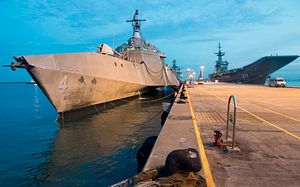The U.S. Navy’s only overseas Littoral Combat Ship (LCS) is heading home after a 14-month rotational deployment to Southeast Asia. The Independence-class LCS USS Coronado departed Singapore on November 4, the U.S. Navy announced in a recent statement. The ship is now en route to its homeport of San Diego.
The USS Coronado was the first Independence-class LCS deployed to Southeast Asia and follows the rotational deployment of the LCS Freedom-class variants USS Freedom and USS Fort Worth. The LCS class consists of two separate variants, the trimaran-hull Independence-class and the single-hull Freedom-class.
“The rotational deployment of USS Coronado demonstrated the relevance of LCS as a platform tailor made for the dynamic and congested sea lanes, straits, and archipelagos of South and Southeast Asia, providing flexible options and tactical advantages,” said Rear Admiral Don Gabrielson, the commanding officer of the Singapore-based Task Force 73.
“The Navy remains committed to the rotational deployment of LCS to the Indo-Asia-Pacific and views the LCS as a pillar of future U.S. maritime presence in Southeast Asia,” he added.
According to the service, the USS Coronado achieved many operational milestones for the LCS program, including coordinating counterpiracy operations with the Philippine Navy in the Sulu Sea and inaugural port visits to Cam Ranh, Vietnam and Lamut, Malaysia.
The USS Coronado was the first LCS to be fitted with an advanced anti-ship missile system, the so-called Advanced Harpoon Weapon Control System (AHWCS) capable of firing RGM-84D Harpoon Block 1C missiles.
In August, the USS Coronado successfully conducted a live-fire exercise of the GM-84D Harpoon Block 1C missile system near the coast of Guam on August 22, alongside the Republic of Singapore Navy. During RIMPAC 2016, the LCS also test-fired a Harpoon missile, with mixed results (See: “RIMPAC 2016: US Navy Test-Fires Anti-Ship Missile From Littoral Combat Ship”).
“The ship also contributed to regional maritime security through routine presence operations in the South China Sea, Philippine Sea, Andaman Sea, and the Straits of Malacca and Singapore,” the Navy states.
The USS Coronado arrived at Changi Naval Base in Singapore in October 2016. “En route to Singapore, the Coronado suffered an engineering casualty in the Western Pacific in August 2016,” I explained in August. As my colleague Steve Stashwick reported earlier this year, once in Singapore the trouble for the Coronado’s crew was far from over:
Major changes to the LCS crew concept and training pipeline to address some of the earlier high-profile problems meant that the follow-on crew was severely delayed, and crew that took the ship from the United States to Singapore ended up having to spend nine months on board instead of four or five.
In June, the U.S. Navy announced plans to simultaneously deploy two LCS to Singapore in 2018.

































